This quick and easy Parsley Pesto Recipe combines fresh Italian parsley, olive oil, walnuts, cheese, and garlic. With just a few pulses in your food processor, you can create a fresh, homemade, no-cook sauce for pasta, fish, vegetables, potatoes, and much more!
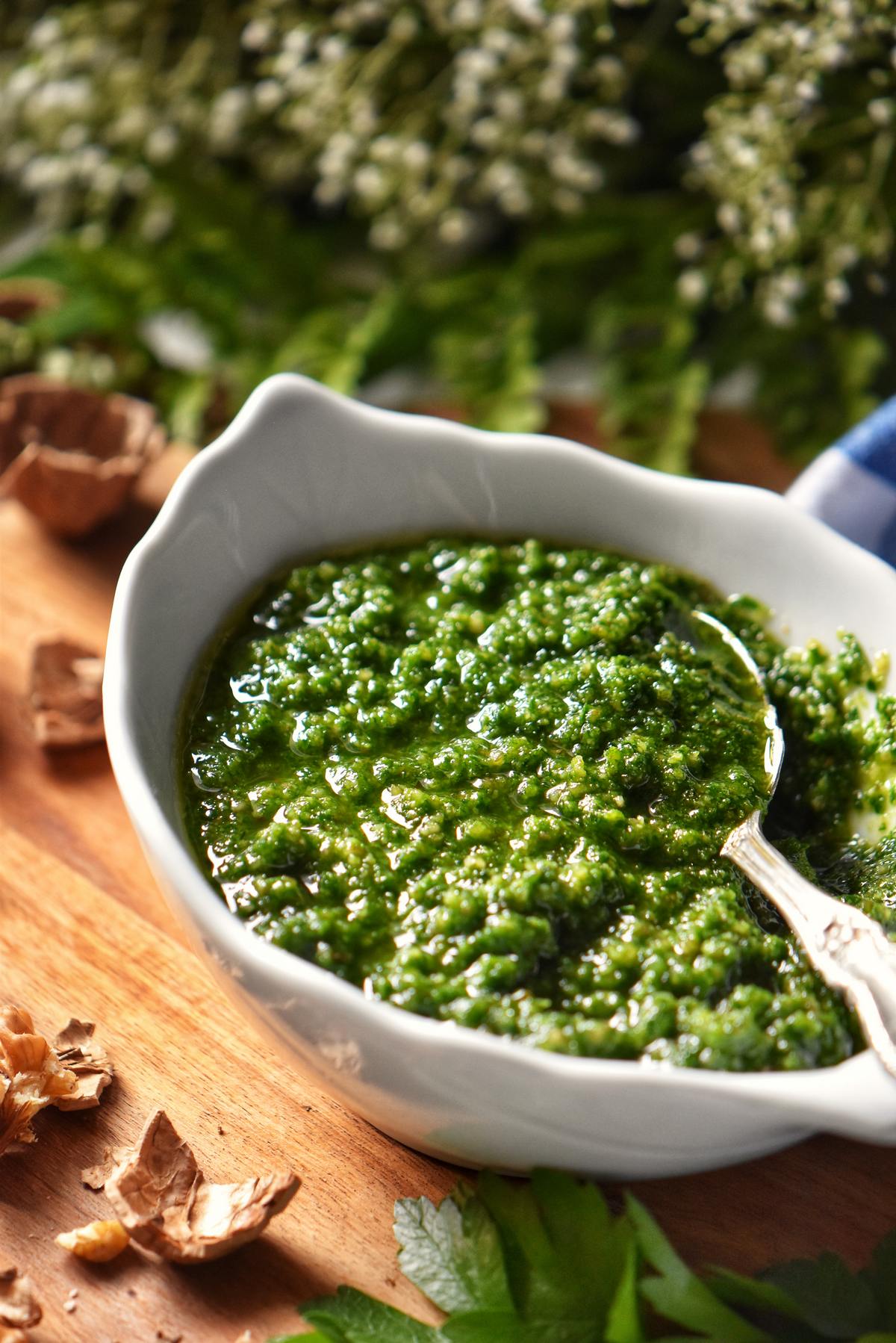
When I think of pesto, I always picture the classic basil version, probably because of my Italian roots.
But guess what?
You can make a delicious and lively pesto using fresh Italian flat-leaf parsley as the main ingredient!
This parsley pesto brings a bright, herby flavor, offering a tasty twist on the traditional basil pesto recipe.
If you have an excess of parsley from your garden or the local farmer’s market, this pesto recipe is a great way to preserve it. Another great option is freezing parsley for later use.
Before we look at the step-by-step process for making this vibrant pesto, here are the ingredients I use.
Jump to:
Ingredients
- Garlic cloves: Adds pungent, aromatic flavor. For a milder taste, consider blanching or roasting garlic before use.
- Walnuts: Provide a rich, nutty taste and creamy texture. To intensify their flavor, I like to toast the walnuts before blending.
- Romano cheese: Offers a sharp, savory flavor. Parmesan cheese can be used as a substitute.
- Fresh Italian Flat-Leaf Parsley: The star ingredient, bringing a bright, herbaceous flavor. Avoid using the curly leaf variety.
- Extra virgin olive oil: Binds the ingredients and adds a luxurious, fruity note. Using a high-quality oil makes all the difference.
- Kosher salt and black pepper: Enhance overall flavor. Adjust according to personal taste.
- Fresh Lemon Juice (optional): A squeeze adds brightness and freshness. Adjust to taste.
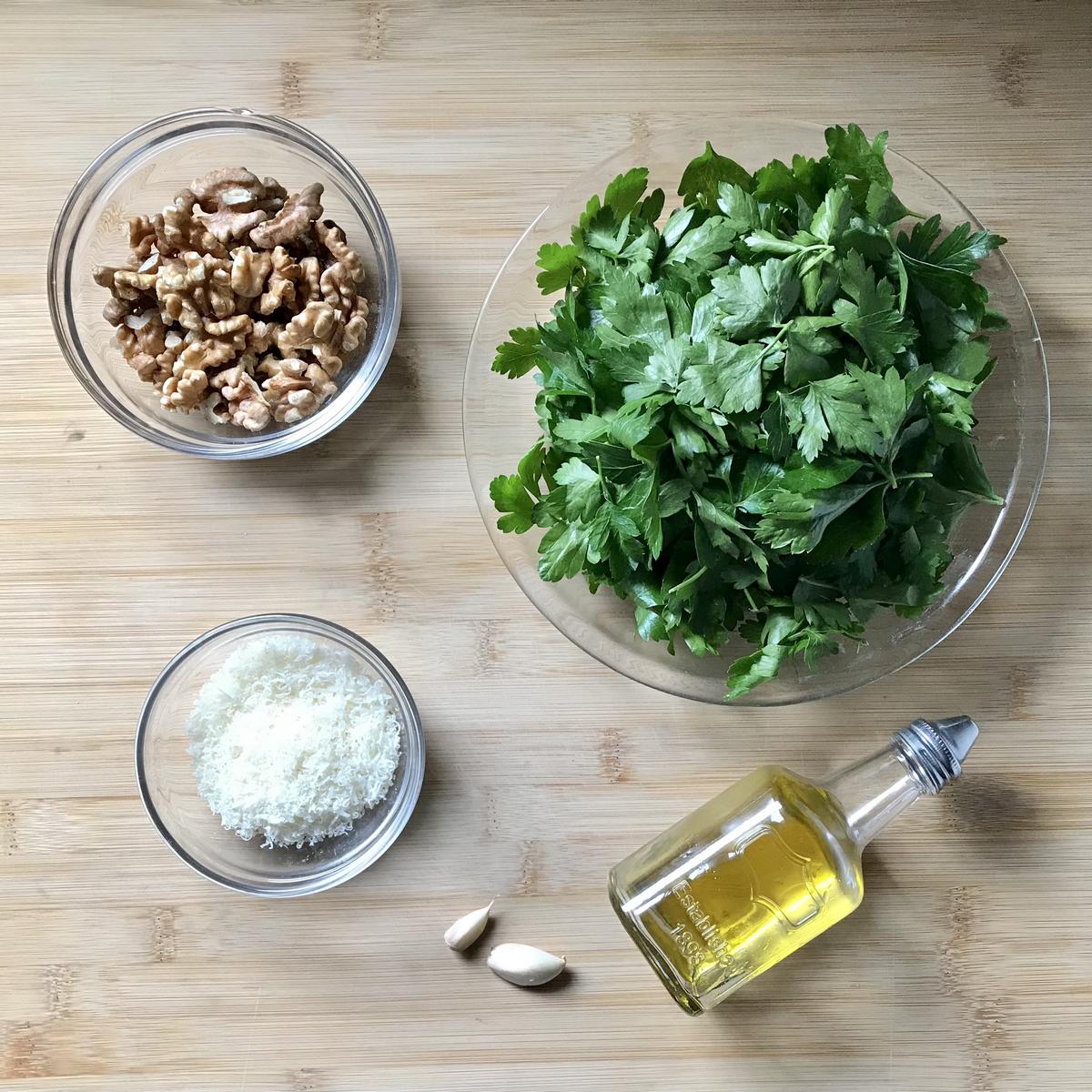
Mise en place
Although the recipe takes mere minutes to come together in a food processor, we need a small investment of time to prepare the ingredients. Let’s begin by toasting the walnuts.
Prep the walnuts: Place ¾ cup of chopped walnuts over medium-low heat in a small skillet, shaking the pan occasionally. They will take about 5 minutes to get lightly browned and fragrant. Transfer from the hot pan to a bowl to cool down completely.
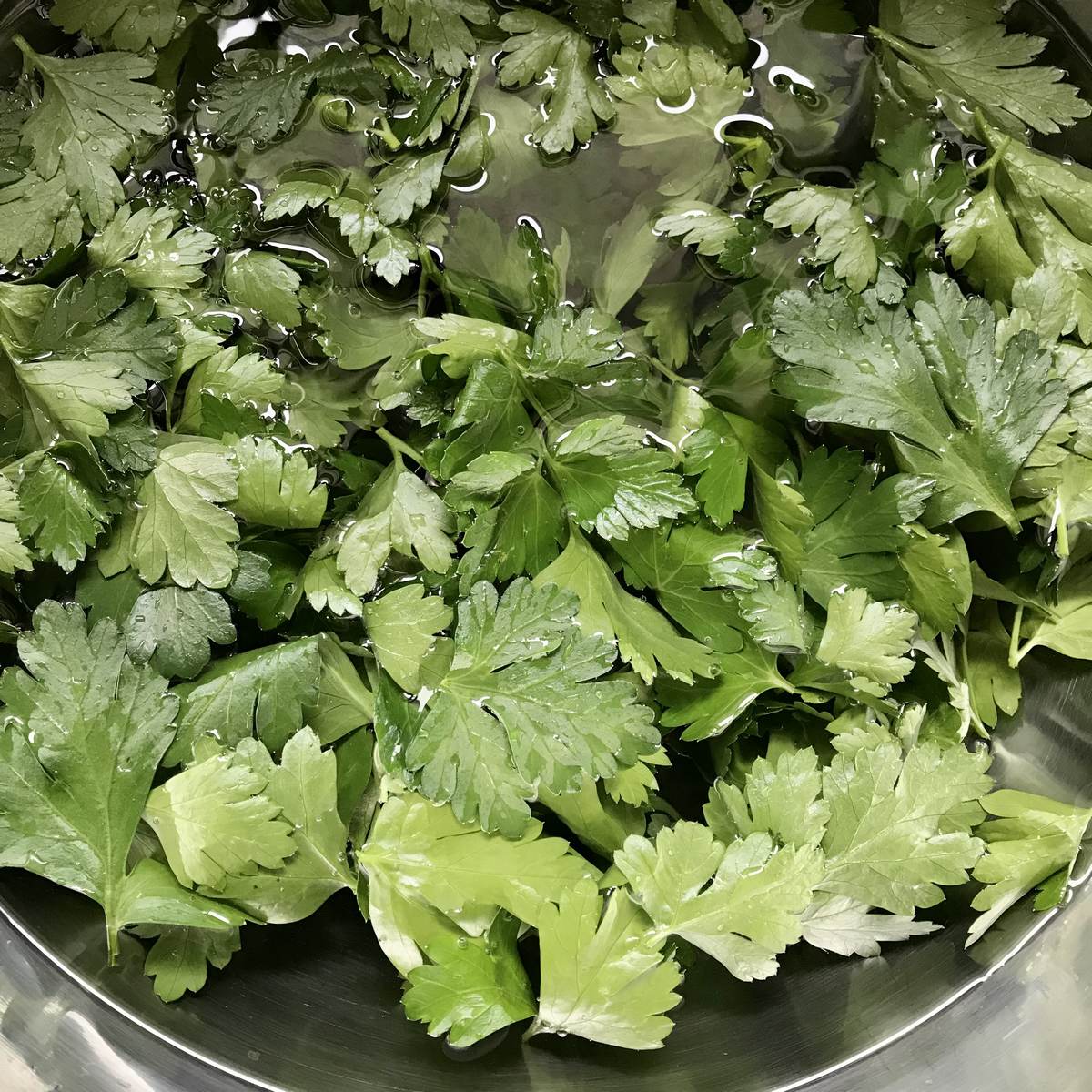
Prep the parsley: Place one bunch of fresh parsley leaves in a large bowl of water and swish it around. If the stems are delicate, there is no need to separate them from the parsley leaves. If the parsley stalks are tough, remove the leaves from the long stems. You should have about 2 cups of loosely packed leaves or approximately 50 grams.
Next, remove the excess moisture by spinning them in a salad spinner. If you do not have one, spread the leaves over a tea towel and gently pat dry with another. Paper towels can also be used. Then, you can spread the leaves out over a tea towel and air dry them while we get the rest of the ingredients together.
Prep the cheese: Grate about ⅓ cup or 10 grams of Romano cheese.
Prep the garlic: Rather than simply adding the garlic cloves to the food processor, we need to grate or mince the garlic before adding it. Use 1-2 cloves, depending on your personal preference.
How to make parsley pesto
In the bowl of a food processor, add the minced garlic clove, ¾ cup of toasted walnuts, ⅓ cup Romano cheese, 2 cups of loosely packed fresh flat-leaf parsley, ⅛ teaspoon of Kosher salt, and a pinch of black pepper.
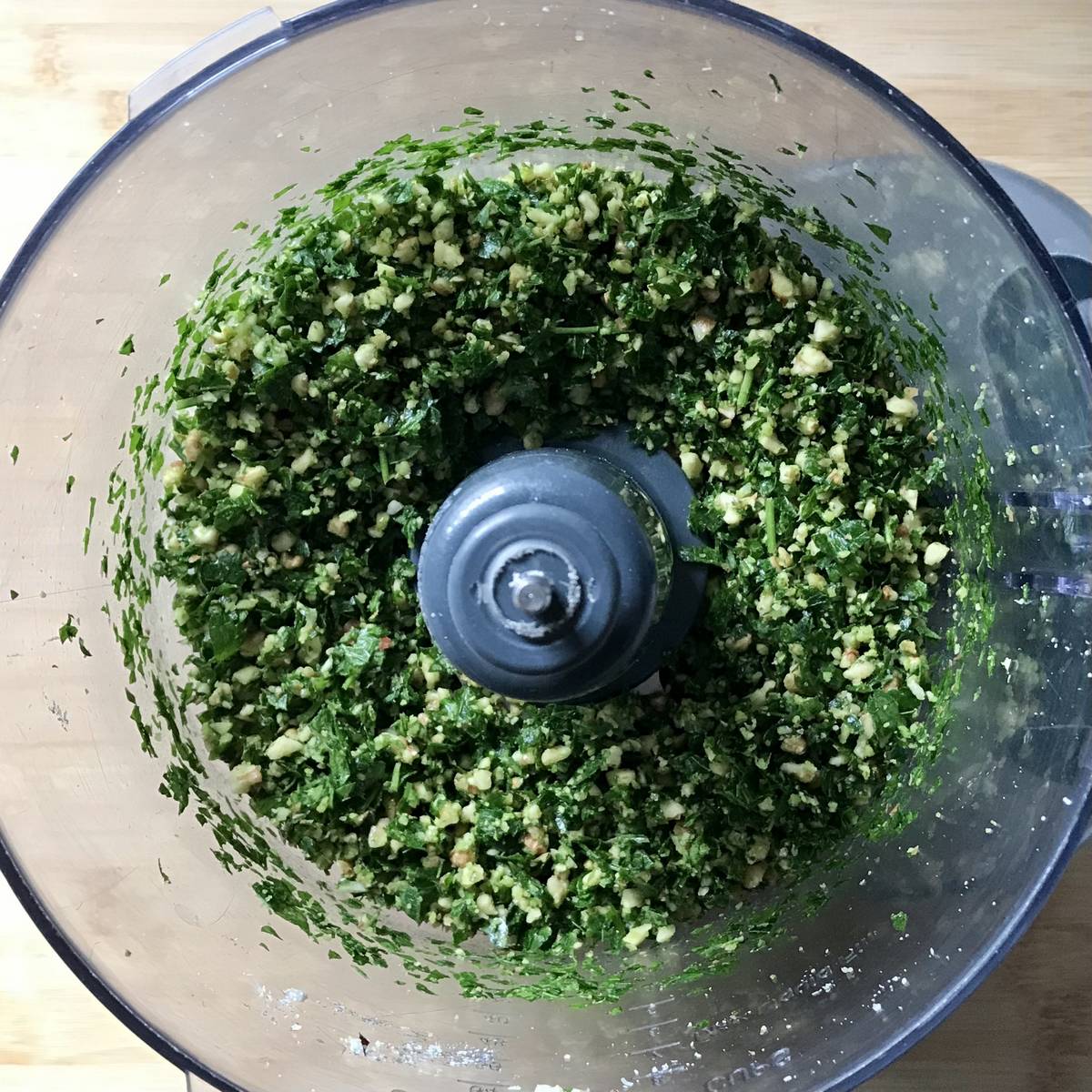
Pulse together for 30 seconds or until coarsely chopped. Scrape down the sides of the bowl.
With the food processor on low, slowly drizzle ¼ cup of olive oil in the feed tube and run for 30-60 seconds or until desired consistency.
Taste and adjust the seasonings.
Tips
- Take care when toasting the chopped walnuts, as the process goes very quickly. You do not want burned nuts in the recipe.
- Measure the fresh, whole parsley leaves by packing them loosely in your measuring cup. Be sure to remove the stems if tough.
- Adjust its thickness by adding more olive oil depending on what you are using your pesto for.
- Freshly grated cheese always tastes better.
- Replace the Romano cheese with Parmigiano Reggiano.
- If not using immediately, add about ½ teaspoon freshly squeezed lemon juice and drizzle olive oil over top before refrigerating.
FAQ
Like this herb sauce, pesto can be stored in the refrigerator for up to 3 days. Add ½ teaspoon of fresh lemon juice and drizzle a little olive oil over the top to keep the bright green color and flavor fresh.
Yes! Freeze parsley pesto by pouring it into a freezer-safe container or using an ice cube tray for easy portioning. Once frozen, transfer the cubes to a freezer-safe bag or container. Enjoy within 3 months. I find it tastes better to freeze it without the cheese; I add it after defrosting for the best flavor.
Yes, toasted or roasted garlic can be used in any pesto recipe. This creates a milder, slightly sweeter pesto.
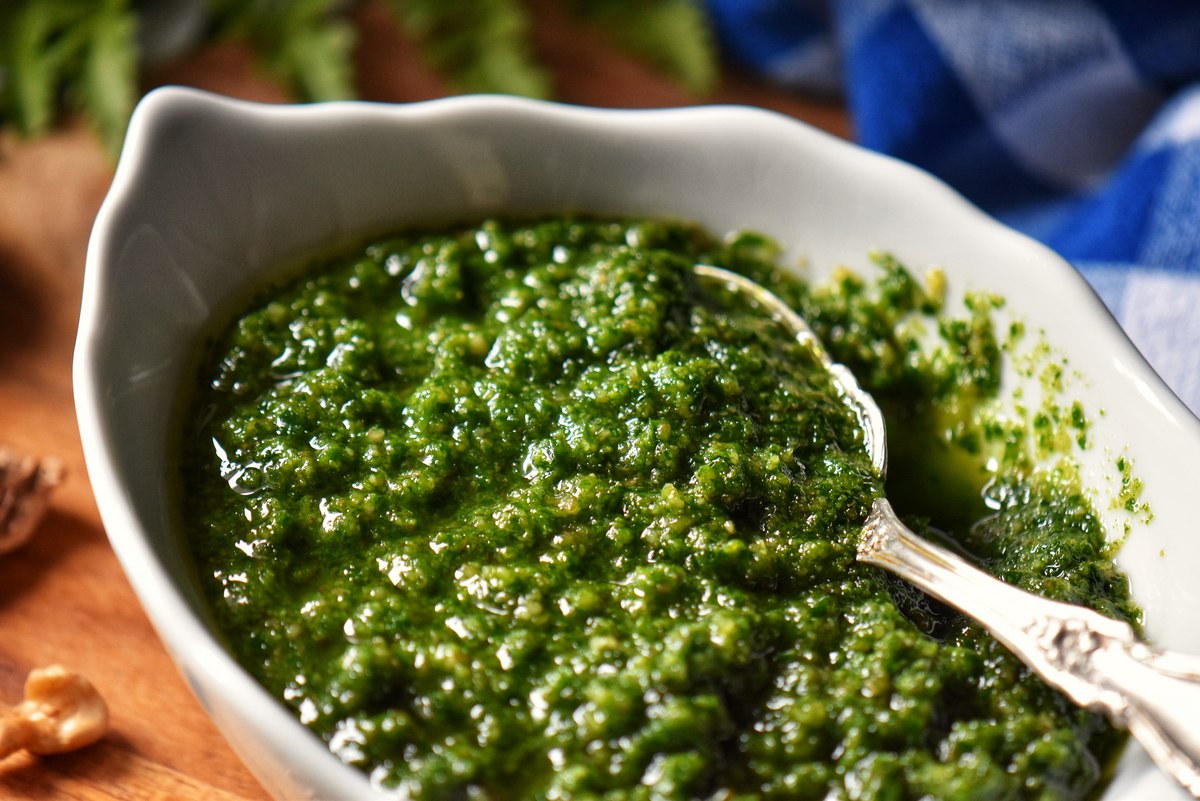
How to use pesto
Parsley pesto offers a versatile flavor for a wide variety of recipes and meals. Once you discover how much you love its taste, you may want to add it to everything.
It’s nearly impossible to list all the ways to use parsley pesto in your kitchen. Next time you have an overabundance of parsley from your garden or market bag, consider these options.
- It is a great alternative to tomato-based pasta sauce.
- Consider coating chicken breasts or lamb with a thin layer of parsley pesto sauce before baking or using it as a thick grilling marinade.
- Drizzle it on green beans, spoon it over roasted turnips or radishes, and mix it into casseroles before cooking. It works well anytime you want a unique Italian flavor.
- Stir a spoonful into your favorite soup or stew.
- Use it as a sandwich spread or dip for Italian focaccia bread.
- Dip crudités in it for a healthy snack or easy appetizer.
- Mix it in mashed potatoes, rice, or couscous for a flavorful side dish.
- Add a dollop to a frittata for a yummy brunch treat.
- Create a heartier dip by adding it to sour cream or yogurt.
- Combine it with a vinaigrette salad dressing for a more intense flavor.
- Add a few spoonfuls to risotto.
- Use it as a base to make a pesto pizza.
More pesto recipes
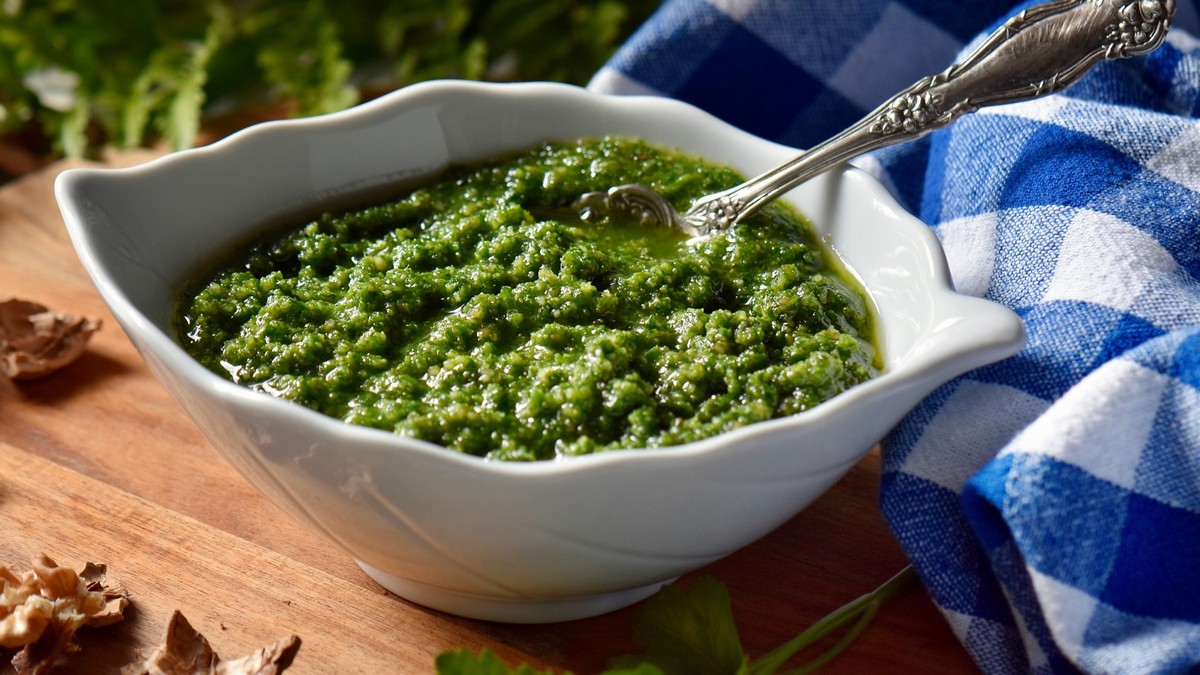
Recipe origins
One of the benefits of having a backyard garden is having fresh produce that is easily available to experiment with.
I remember making this parsley pesto as “an experiment” one summer because I had so much flat-leaf parsley!
Needless to say, it quickly became one of my go-to summer pesto recipes.
This scrumptious recipe works well with both fresh and frozen parsley. As it does not rely on the attractive shape of parsley leaves, chopped and frozen ingredients work quite well to add a unique herbal flavor and bright green color.
It is super easy to make, stores well in the refrigerator, and goes with a wide variety of meals, so you will always want some parsley pesto available for a lunchtime salad, pasta side dish, or main dish sauce.
I hope you get a chance to try it. Enjoy!
THANKS SO MUCH for following and being part of the She Loves Biscotti community, where you will find Simple & Tasty Family-Friendly Recipes with an Italian Twist.
Ciao for now,
Maria
★★★★★ If you have made this parsley pesto recipe, I would love to hear about it in the comments below and be sure to rate the recipe!
Recipe
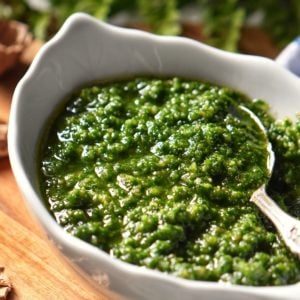
15-Minute Parsley Pesto Recipe
WANT TO SAVE THIS RECIPE?
Ingredients
- ¾ cup walnuts toasted
- 1-2 cloves garlic minced
- ⅓ cup Romano cheese freshly grated
- 2 cups parsley about 50 grams, fresh, loosely packed, rinsed and dry
- ¼ cup extra virgin olive oil
- ⅛ teaspoon kosher salt
- pinch black pepper
Instructions
- Pulse together walnuts, minced garlic, cheese and parsley leaves in a food processor until coarsely chopped.
- Drizzle the olive oil while the food processor is whirling until smooth and thick, approximately 30-60 seconds.
- Add salt and pepper. Season to taste.
- Use immediately or refrigerate for up to 3 days.
Video
Notes
- Take care when toasting the chopped walnuts as the process goes very quickly. You do not want burned nuts in the recipe.
- Measure the fresh, whole parsley leaves by packing them loosely in your measuring cup. Be sure to remove the stems.
- Depending on what you are using your pesto for, adjust its thickness by adding more olive oil.
- Freshly grated cheese always tastes better.
- Replace the Romano cheese with Parmigiano Reggiano.
- If not using right away, add about ½ teaspoon freshly squeezed lemon juice and drizzle a little bit of olive oil over top before refrigerating.
Nutrition
I originally published this post on July 10, 2021, and republished it on June 6, 2024, with updated content. Thanks for sharing.



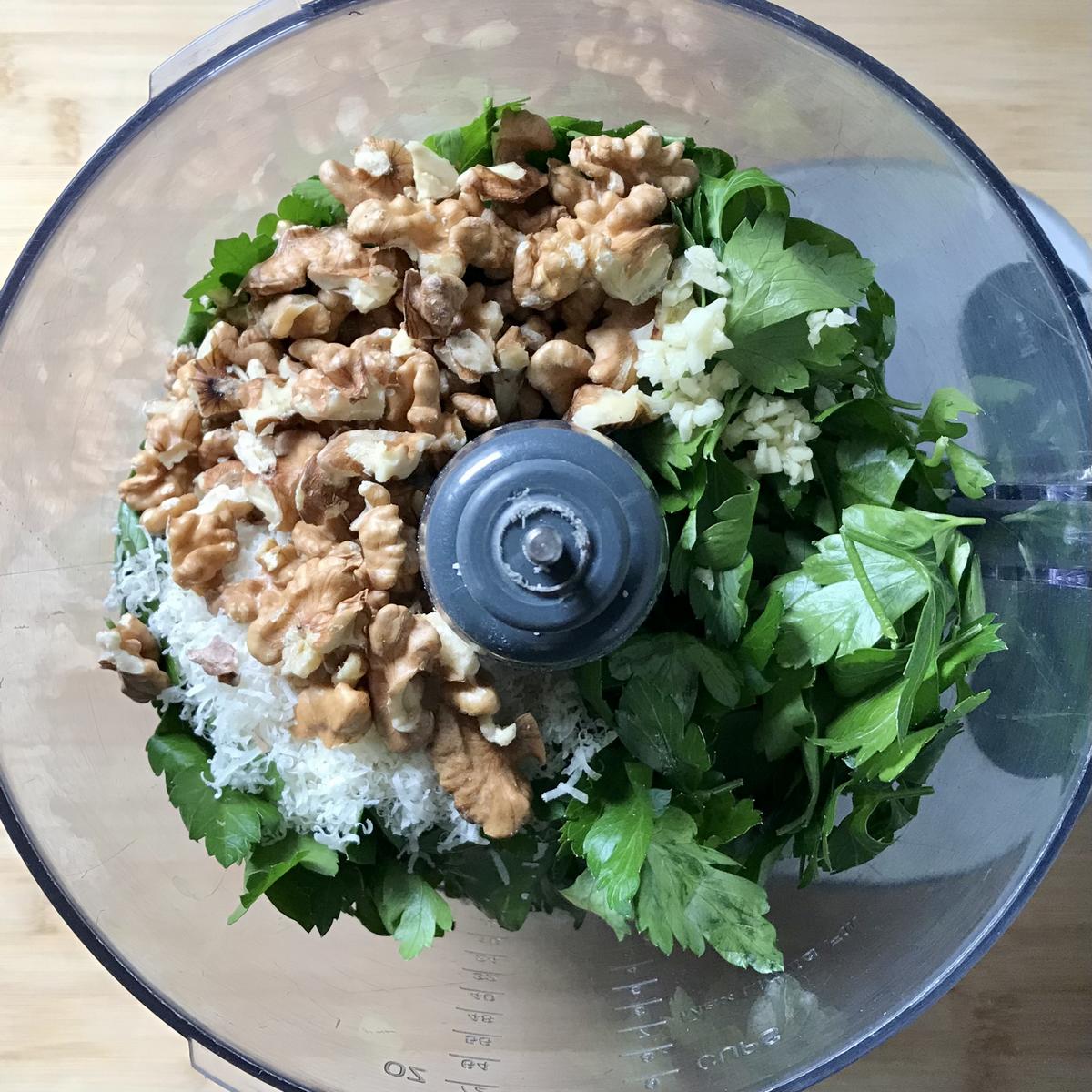
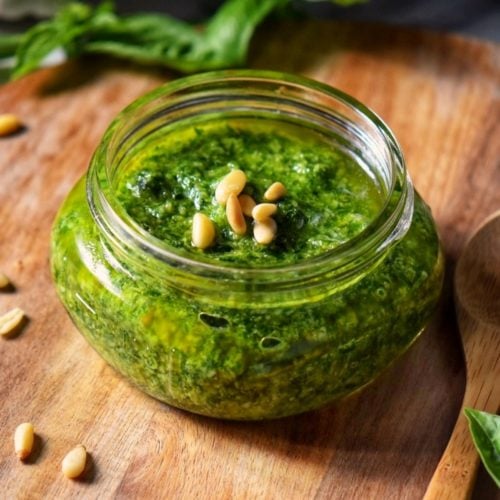

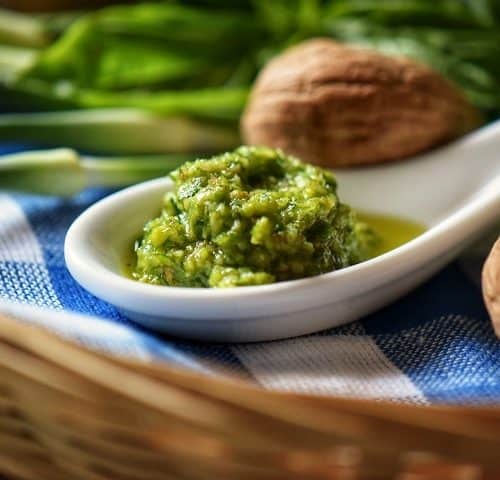
Maria murdaca
This parsley pesto is really delicious and easy to make . I added a few tablespoons of red wine vinegar.
Maria
Great idea Maria! Thanks for sharing!
Donna B.
THIS is the pesto my Italian Mom always made! In rural Pennsylvania in the 60s and 70s, we didn’t often have access to basil, so parsley was the major player. She didn’t include nuts, though, but occasionally I make it with pine nuts (toasted lightly). I absolutely love this pesto on just about anything. Pasta best, of course, but also sliced boiled potatoes (sometimes, with steamed Italian green beans). Broiled or grilled chicken or fish or lean pork chops, And a dollop in soup or stew is wonderful! And, seriously, a schmear of this pesto on hot garlic bread? Yes, please!
Maria
Thanks so much for taking the time to share Donna! Parsley pesto really is so very flavorful!
joanne
i have tried preserving parsley all sorts of ways,,,this year i’m going to make pasto..BUT leave out the garlic. cheese.& walnuts..i do that when i make basil peato…i add all those things BEFORE adding into dishes…i’ve tried different freezing methods did’t care for the results…when i process the leaves then i add EVO.. till smooth NO SALT OR PEPPER. put it into small 1/2 pt jars and vacuum the jars..store in frig.they will keep all winter without mould on top.. i found that by adding garlic. cheese. walnuts before i vacuum seal.. it seems to loose it’s freshness and taste
Maria
Thanks for sharing your method for preserving parsley—it’s always interesting to hear different techniques! Happy preserving, and enjoy your fresh parsley pesto all winter long!
val
This is such a great idea! Can’t wait to try this.
Maria
Thanks Val. It really is so convenient when it is readily available.